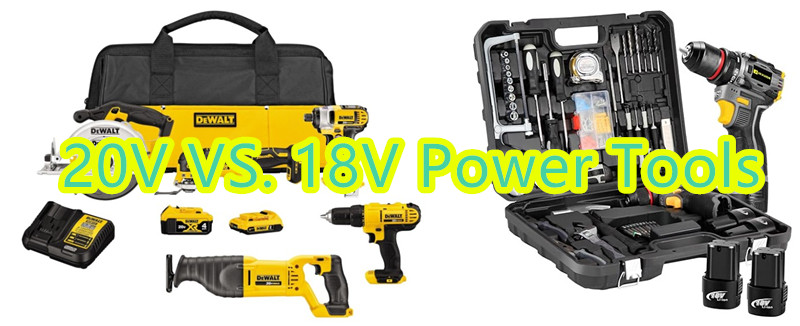
20V vs 18V Power Tools
Understanding the core differences between 20V and 18V power tools is essential for professionals and DIYers navigating cordless tool ecosystems. Despite marketing labels, both platforms use identical lithium-ion battery technology—five cells in series—delivering ~20V when fully charged and ~18V under load. This nominal voltage distinction is regional (e.g., “20V MAX” in North America vs. “18V” globally) rather than technical. Here, we dissect performance nuances, real-world applications, and cross-brand compatibility to guide your investment.
While the underlying batteries are the same, performance variations arise from tool design, motor efficiency (brushed vs. brushless), and battery quality. Consider two similarly constructed drills:
Torque and Speed: An 18V/20V brushless drill (e.g., DeWalt DCD795D2) typically delivers 450–650 unit watts out (UWO) with variable speeds (0–2,000 RPM) and high impact frequencies (e.g., 34,000 BPM) for drilling and light masonry work. Identical models sold as “18V” in Europe and “20V MAX” in the U.S. share identical performance specs.
Practical Output: Higher voltage platforms sustain power better under heavy loads. Drilling a ½” hole through dense lumber or metal exposes this: a quality 20V MAX/18V brushless drill maintains speed, while a budget model (even at 20V) may stall due to inferior electronics or motor design.
Weight and Handling: Voltage labels don’t dictate ergonomics. For example, DeWalt’s 20V MAX XR drill (DCD795D2) weighs ~3.6 lbs, comparable to premium 18V European models like Metabo’s brushless drills.
Drill Drivers exemplify this:
| Feature | 18V/20V Drill (e.g., DeWalt DCD795D2) | 12V Drill (e.g., Bosch FlexiClick) |
|---|---|---|
| Torque | 450–650 UWO (Unit Watts Out) | Up to 35 Nm (e.g., Ronix 8620)7 |
| Speed | 0–2,000 RPM | 0–1,500 RPM |
| Weight | ~3.6 lbs (with battery) | ~1.33 lbs (Ronix 8620)7 |
| Clutch Settings | 15–20+ | 18 (Ronix 8620)7 |
Saws (circular, reciprocating, miter) benefit more substantially from high-voltage platforms due to sustained power needs:
Cutting Capacity: An 18V/20V brushless circular saw (e.g., Makita XSH06Z) leverages the 5-cell battery’s voltage to drive ~5,000 RPM for cutting 2x lumber or sheet materials. Lower-voltage 12V saws often struggle beyond 1” depth.
Runtime and Heat Management: Saws drain batteries rapidly. A 20V MAX 5.0Ah battery (90Wh) offers ~30% longer runtime than a 4.0Ah 18V pack (72Wh), crucial for prolonged cutting10. Brushless motors further optimize efficiency, reducing heat buildup during demanding tasks.
Heavy-Duty Limitations: For deep cuts in hardwoods or concrete, 18V/20V cordless saws still trail corded or 60V Flexvolt tools. DeWalt’s 20V MAX circular saw (DCS570B) accepts Flexvolt batteries for enhanced power, blurring the voltage line.
Circular and pole saws highlight these differences:
| Parameter | 18V/20V Brushless Circular Saw | 20V Pole Saw (e.g., Bauer) |
|---|---|---|
| Cutting Capacity | 2x lumber at ~5,000 RPM (Makita XSH06Z) | 7.4″ diameter limbs, 14 ft reach |
| Runtime | ~30 mins (5.0Ah battery) | ~50 mins (1.5Ah battery, Ronix drill metric) |
| Weight | 6.5–7.5 lbs | 7 lbs (lighter than Milwaukee’s 16-lb model) |
| Key Use Case | Sheet materials, framing | Landscaping, pruning branches |
Physical compatibility does not guarantee electrical or functional compatibility. DeWalt’s ecosystem illustrates key nuances:
DeWalt 20V MAX ↔ 18V Tools: Yes, with caveats. Mechanically, 20V MAX batteries fit older 18V NiCd tools only using DeWalt’s DCA1820 adapter. Electrically, they work because both systems operate at ~18V under load. However, 20V MAX Li-ion batteries cannot directly slot into legacy 18V tools without this adapter.
Critical Incompatibility: DeWalt’s Flexvolt tools (60V) cannot use 20V MAX or 18V batteries. Physically, PowerStack/20V MAX packs don’t fit Flexvolt docks. Electrically, 20V is insufficient for 60V tools.
Third-Party Adapters: Products like the DL18ML adapter enable DeWalt 20V batteries on Milwaukee M18 tools. However, bypassing OEM specifications risks voiding warranties and triggering tool/battery protection circuits.
For a deep dive on cross-brand compatibility, see Power tool Battery Interchange Guide.
Professional Recommendation:
Choosing Your Platform: For Home DIYers: A 12V system suffices for light drilling/driving. Step up to 18V/20V only if drilling masonry (impact drills) or thick wood (saws) is needed.
Trades and Heavy Users: Invest in a brushless 18V/20V kit (e.g., DeWalt XR, Makita LXT). Prioritize battery quality (e.g., 5.0Ah+ packs) and series compatibility—DeWalt’s 20V MAX ecosystem allows sharing batteries among 100+ tools.
Critical Tip:
Ignore voltage labels; focus on torque (Nm/N-m), RPM, BPM/IPM, and battery watt-hours (Wh). A “20V” drill with 30Nm torque is outperformed by a “12V” drill delivering 35Nm (e.g., Bosch FlexiClick).
The move toward universal battery systems (e.g., Saker’s 200W inverter converting DeWalt 20V batteries to 120V AC power) underscores that battery ecosystem synergy—not voltage alone—defines modern tool flexibility.
Final Verdict: 18V vs. 20V is a regional labeling difference, not a performance chasm. Your priority should be brand commitment and battery quality, ensuring long-term access to tools sharing the same voltage architecture. DeWalt’s 20V MAX and Makita’s 18V LXT exemplify how mature platforms transcend nominal voltage to deliver professional results.